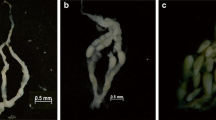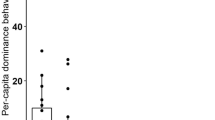Summary
-
1.
The egg-laying behaviour of Bombus terrestris workers was studied in a captive colony by means of video recordings, in order to determine factors that make workers become egg-laying workers.
-
2.
The size of a worker as a factor determining her to become a laying worker is only important for the workers that are born from the first batch of eggs. The sequence in which workers are born determines which workers are to become egg-laying workers and which are not.
-
3.
Prospective egg-laying workers seek the proximity of the queen for a long period preceding their oviposition and tend not to participate in foraging activities. Workers who are pre-eminent in having interactions with the queen are the first to lay eggs. These workers compete with the queen for opportunities to lay eggs and finally push the queen off the comb.
-
4.
There is strong competition between workers with regard to the acquisition of opportunities to lay eggs. As the ovaries of the workers develop, the interactions between workers and between workers and the queen become more openly agonistic. Egg-laying workers inhibit oogenesis in younger workers.
Similar content being viewed by others
References
Free JB (1955) The behaviour of egg-laying workers of bumble-bee colonies. Br J Anim Behav 3:147–153
Free JB (1957) The effect of social facilitation on the ovary development of bumble-bee workers. Proc R Entomol Soc (Lond) 32:182–184
Free JB (1961) The social organisation of the bumble-bee colony. Fleet, 11 pp
Honk CGJ van, Velthuis HHW, Röseler PF, Malotaux ME (1980) The mandibular glands of Bombus terrestris queens as a source of queen pheromones. Ent Exp Appl 28:191–198
Katayama E (1971) Observations on the brood development in Bombus ignitus. I. Egg-laying habits of queen and workers. Kontyû 39:189–203
Röseler PF (1974) Vergleichende Untersuchungen zur Oögenese bei weiselrichtigen und weisellosen Arbeiterinnen der Hummelart Bombus terrestris. Insectes Soc 21:249–274
Röseler PF, Röseler I (1977) Dominance in bumble-bees. Proc VIIIth IUSSI, Wageningen, pp 232–235
Röseler PF, Röseler I, Honk CGJ van (1981) Evidence of a bumble-bee queen's pheromone inhibiting the activity of corpora allata in Bombus terrestris workers. Experientia 37:348–351
Sachs L (1978) Angewandte Statistik. Springer, Berlin Heidelberg New York
Sladen FWL (1912) The humble-bee, its life history and how to domesticate it. MacMillan, London
Author information
Authors and Affiliations
Rights and permissions
About this article
Cite this article
van Honk, C.G.J., Röseler, P.F., Velthuis, H.H.W. et al. Factors influencing the egg laying of workers in a captive Bombus terrestris colony. Behav Ecol Sociobiol 9, 9–14 (1981). https://doi.org/10.1007/BF00299847
Received:
Issue Date:
DOI: https://doi.org/10.1007/BF00299847




